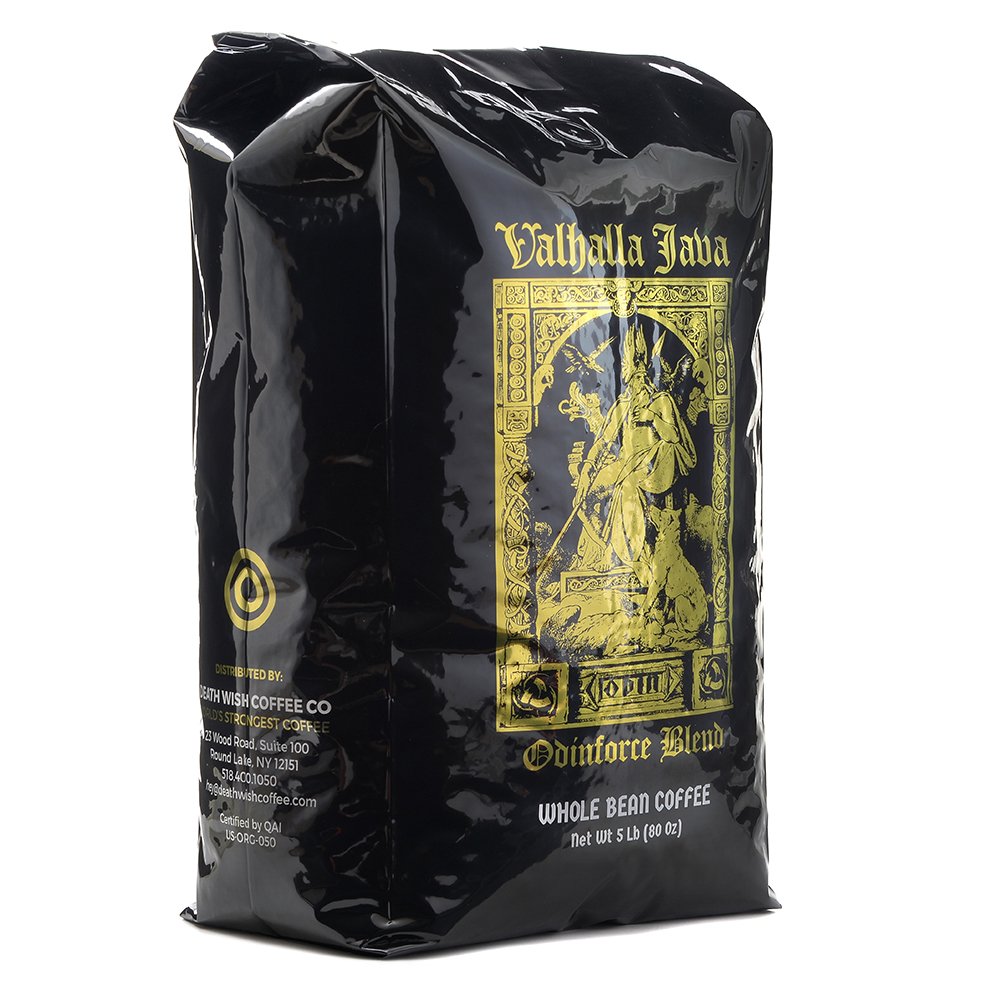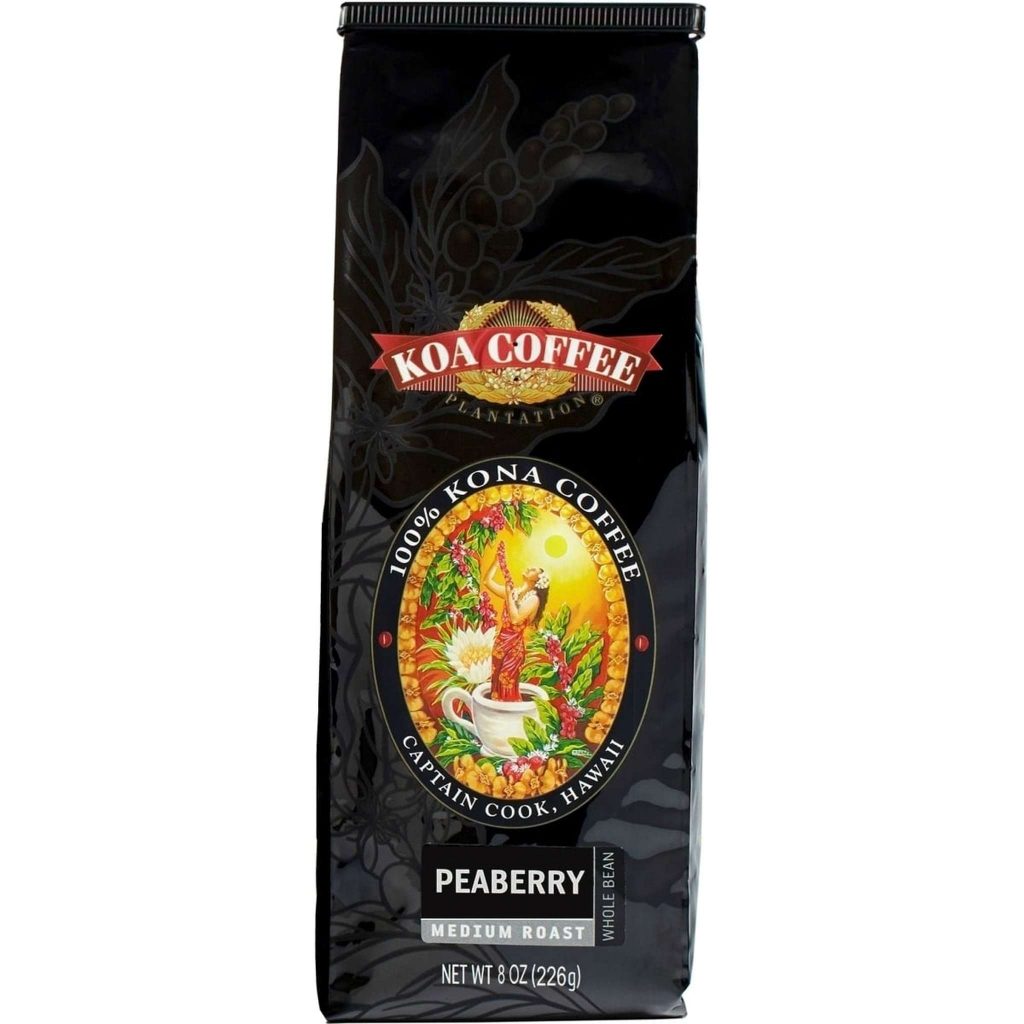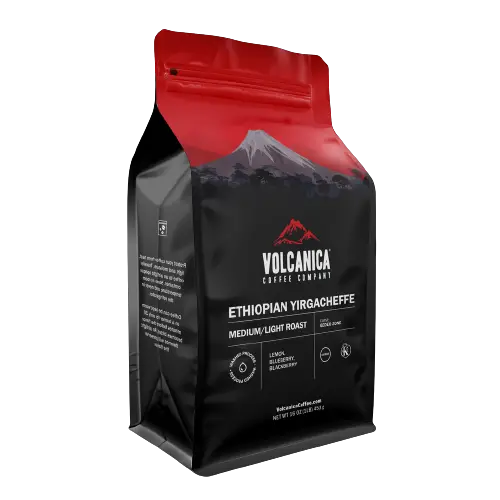Finding the best coffee beans is no easy feat, especially for the avid coffee drinker. How do you even start finding the best roasts, considering there are so many different options out there?
Then you also have to choose between light roast, medium roast, and dark roast! Needless to say, beginners can spend a lot of time on finding the best coffee bean for their personal taste preferences.
That’s why we’ve created the perfect guide on how to find the best whole bean coffee.
We’ll discuss important aspects such as flavor notes, roast types, bean types, and other variables such as brewing methods.
By combining all these different factors, finding the best coffee beans suddenly becomes a little easier.
Come join us to explore the world of whole bean coffee.
Quick summary of our favorite coffee beans

When it comes down to the best coffee beans, you will find whole bean coffee from the Death Wish Coffee Company in more than my review. In fact, roast coffee from the Death Wish Coffee Company is arguably one of the most popular for coffee connoisseurs and worth adding to your list.

LifeBoost Coffee is organic and really easy on the stomach. They’ve burst onto the coffee scene only recently and have glowing recommendations from doctors and their customers. Their coffee is slightly more expensive than most, but the taste and low acidity makes it a huge favorite.
Best Whole Bean Coffee: Our Favorite Picks
Lifeboost Organic Coffee

Roast level: Lifeboost Organic Coffee is considered stomach friendly, which has a lot to do with the way the beans are roasted. However, Lifeboost does mention that the type of roast you drink can influence stomach discomfort. If you are prone to such things, Lifeboost Organic Coffee recommends medium and darker roasts.
Flavor notes: Lifeboost Organic Coffee offers single origin coffee, which means it provides more authentic flavors that were not mixed with other types of coffee beans. This also means that the roast profile is the same for each bag of whole beans you purchase.
Organic coffee from Lifeboost is characterized by a relatively bold flavor, but somehow remains smooth. Considering the bolder flavor notes throughout the coffee, it is considered a popular gourmet coffee. Lifeboost is also fair trade, so you can have your coffee completely guilt-free.
Hawaiian Kona Coffee

Roast level: Koa Coffee Peaberry is a medium roast Kona coffee. Peaberry is a unique coffee as most coffee fruits have two coffee beans inside them. Peaberry coffee is a variant that has a single coffee bean inside each coffee cherry.
Flavor notes: Peaberry coffee is wonderfully smooth and full-bodied, and is considered a delicacy amongst coffee beans.
If you’ve never tried Peaberry coffee before, I definitely suggest giving it a shot. You’ll really enjoy it!
Valhalla Java Whole Bean Coffee
Roast level: Like you come to expect from the people at the Death Wish Coffee Company, their Valhalla Java delivers a remarkable combination of boldness and smoothness. This roast consists of a remarkable five different coffee beans with both robusta and arabica. In addition to that, Valhalla Java is completely organic and fair trade!
Flavor notes: Valhalla Java has a dominant and robust flavor due to the combination of robusta and arabica beans. Some have compared the flavor of this coffee with 14th century Europe, with visions of ancient blacksmiths, Viking longboats and I must admit they are not far off.
Valhalla Java is a true adventure, albeit a coffee adventure just waiting to be experienced. It is a so-called high-octane coffee as well, so in addition to good flavor, you also receive a burst of energy with your morning cup.
Koffee Kult Dark Roast
Roast level: Koffee Kult’s Dark Roast is unique in many regards. In particular, this coffee is roasted in small batches and immediately packaged after roasting. So, consumers can expect the freshest whole beans to arrive on their doorstep. The roast also consists of different coffee beans from Columbia, Guatemala as well as Sumatra, making this blend quite interesting indeed.
Flavor notes: Much like the blend itself, the flavor and aroma of Koffee Kult’s Dark Roast is quite interesting indeed.
Thanks to the combination of Colombian, Guatemalan and Sumatran coffee beans, you can expect a robust, exotic flavor with lots of interesting characteristics, even for a dark roast!
Coffee experts will detect a heavy body with a smooth finish, stacked with hints of cinnamon. On top of that, you can also enjoy the unique aromas that come with this small batch coffee.
Sumatra Mandheling Coffee
Roast level: These coffee beans come from the west-central region of Padang. The coffee beans are roasted to medium or dark, which does this particular coffee bean the most justice thanks to its natural sweet taste and earthy notes.
Flavor notes: As you may expect from reading the roast level section, Sumatra Mandheling Coffee has dominant earthy tones throughout. It also sports quite the herbal aroma with some sweetness.
Interestingly, this is quite different from other coffee beans coming from South America and Africa. In other words, this combination is completely unique to the area of Padang.
Sumatra Mandheling also has vibrant tones within it flavor notes, complemented by detectable hints of sweet chocolates and licorice.
Given its rather unique flavor profile, you will find that many coffee experts will try a bag of these whole beans at least once in their life. For some, Sumatra Mandheling becomes an all time favorite.
Ethiopian Yirgacheffe Coffee
Roast level: Ethiopian Yirgacheffe comes from an area situated 1700 to 2200 meters above sea level. It is also a wet processing coffee, which means the coffee is washed. Interestingly enough, due to the height this coffee is grown at, Yirgacheffe coffee is actually the highest grown coffee in the southern part of Ethiopia.
Flavor notes: Consumers can expect a vibrant acidity when they try the Ethiopian Yirgacheffe for the first time. This vibrant character is beautifully complemented by the aroma, which is delightfully complex.
Despite its complexity though, you can expect an intense yet clean taste. In the aroma, you might be able to detect some hints of coconut if you have a fine sense of smell.
This particular coffee has some interesting undertones of berries and wine as well. So, this is probably the ideal cup of coffee for those who like fine wine as well as coffee.
Costa Rica Geisha Coffee

Roast level: Costa Rica Geisha Coffee obviously comes from Costa Rica, in particular the Tarrazu growing region. The roast level of these coffee beans is medium light, and therefore the odd one out in our overview so far.
Flavor notes: Costa Rica Geisha is actually quite the famous coffee. It is known to have quite the sweet flavor. In fact, it would be hard to find a sweeter natural coffee than this one. In addition to that, it also has a special aroma with hints of jasmine, chocolate, honey, black tea, and floral notes.
Please note that the complexity of other flavors inside this coffee is quite similar for other African coffees. That being said, it is the sweetness that makes this particular coffee selection truly special.
Kicking Horse Medium Roast Coffee Beans
Roast level: Kicking Horse Medium Roast has a clear medium roast level. It originates from various areas around the world, this includes Africa, Central America, and South America. These coffee beans are also grown in a sustainable and environmentally friendly manner. And finally, the roasting process for these actually takes place in the Canadian Rocky Mountains.
Flavor notes: Kicking Horse Medium Roast has quite a few interesting flavor notes. Firstly, consumers will notice a strong hint of blackcurrant. Throughout the blend, you will also detect sugar cane, milk chocolate, and honey.
Due to the unique flavor of Kicking Horse Medium Roast, I recommend to only use brewing methods such as drip, pour over, and cold brew. Evidently, these brewing methods are most effective for this particular coffee blend and will do the huge amount of flavors justice.
Stumptown Hair Bender Coffee Beans
Roast level: Stumptown Hair Bender Coffee is a medium roast coffee. It is actually named after the first beauty parlor of the area, which was ironically housed inside the same facility where the coffee is now roasted. Of course, Hair Bender is also the first coffee blend introduced by the founder of Stumptown, which makes it even more special.
Flavor notes: Hair Bender can be described as a sweet and balanced brew, characterized by the typical flavors of Latin America and Africa. The textures of the coffee can find their origin in Indonesia. Therefore, the flavors and textures provided by this coffee bean is certainly balanced. Because of its characteristic flavor, it is often used as an espresso coffee in a variety of artisan cafes.
Peet’s Major Dickason’s Blend Whole Bean Coffee
Roast level:Major Dickason’s Blend is a dark roast, made to deliver richness, complexity, and a full body. And this Peet’s Coffee certainly delivers just that. It is a popular blend for espresso, but also other coffee drinks based on darker roasts.
Flavor notes: Peet’s Coffee Major Dickason’s Blend is almost made for espresso, especially when you think of the complexities in the flavor profile. There is a lot of sweetness, but this is artfully hidden behind hints of chocolate and carbon. And the flavors are not only a hit with coffee fanatics, but it is also the favorite blend of Jerry Baldwin, the director of Major Dickason’s.
Considering the plethora of flavors and the authenticity of the blend, I recommend this particular blend for anyone who prefer traditional coffee flavors. Of course, you can still have this particular coffee with a selection of milk, as it still scores high on the flavor chart even with this additional ingredient.
How to choose good coffee beans: match flavors to the brew method
I may have given you my recommendations, but how do you choose your own best coffee beans? Well, here is an overview of factors to consider when you choose your favorite whole bean coffee, ranging from roast types to flavor notes.
Coffee beans for french press and espresso
Coffee bean flavors should always match the brewing method.
For example, if you prefer French Press or espresso, then you should choose whole bean coffee with deeper caramelized flavors for better results.
Medium-dark and dark roast coffee beans tend to be better for methods such as French Press and espresso.
As you may know, dark and medium roasts are known for their deeper flavors and higher acidity. Therefore, French Press and espresso are mainly recommended for those who love their traditional coffee flavors.
Fortunately, there are many different whole beans that are dark roast and medium roast and come with some lovely intricate flavors to boot. You will also find a good range of fair trade coffee, which is becoming a more and more important factor for many consumers.
Coffee beans for drip and pour over
So, what about traditional brewing methods such as drip and pour over coffee? Well, for these brewing methods, you actually step away from dark roasts and head towards light roast and medium roast coffee beans instead.
Light to medium coffee beans tend to be more balanced than darker roasts, and this is needed for traditional brewing methods such as drip and pour over.
The balance in flavors still delivers a rich flavor, but with less acidity than some of the darker roasted coffees.
As a beginner, it can be a good idea to try a light roast and a medium roast just once to see where you personal taste preference lies. Discovering the different flavors of roast coffees is essential to find the coffee beans that are right for your brew.
Finally, light roasts can also be obtained under the label of fair trade coffee. So, if this is important to you, you can also get your lighter whole bean coffee with the fair trade approval mark.
Coffee beans for cold brew
Naturally, getting the best beans for a cold brew will be completely different compared to the brewing methods I mentioned earlier. In fact, a cold brew should always be done with light and medium whole beans, but specifically those that have a mellow and fruity flavor.
When you compare tasting notes for cold brews, you will notice that some harsher flavors do not work whatsoever, and this is why I recommend fruitier and more mellow flavors for this particular brewing method.
Evidently, this brewing method and matching selection of coffee beans is ideal for anyone who does not like the strong, bitter, and more traditional coffee tasting notes. Instead, you get an easier drinking coffee, but still with plenty of flavors to discover throughout.
While this is not the most consumed type of coffee bean, you will find an incredible amount of options nonetheless. And while you can use medium roasted beans, I do suggest checking out your lighter roasts first and foremost.
Types of coffee beans
Arabica vs robusta
One of the basics you must understand when it comes to coffee bean selection is the difference between arabica coffee beans and robusta coffee beans.
Robusta beans are more bitter and tend to be used for most instant coffee mixes by manufacturers. Arabica coffee beans on the other hand, are the most popular for anyone who want to grind and brew their own coffee, as their flavor is milder and less harsh.
Robusta beans are hardly used for fresh home brewing, but it is not unheard of. If you like bitter and grainy flavors for coffee, then robusta could actually be the better choice for you.
However, if you prefer hints of chocolate, sugar, fruits, or even sweeter tastes in general, then you will find that arabica beans meet your requirements more. If you are still unsure however, do not be afraid to experiment with flavors, so you know where your tastes lie on the tasting notes spectrum.
Single origin coffees vs blends
There is also a difference between single origin and blended coffee beans. To keep things simple, coffee beans with the single origin label actually has a flavor that remained as original as possible.
This means that one type of coffee bean is used in the selection of whole beans. If you have a selection of coffee beans that are blended, it basically means that you have different types of coffee beans in the same coffee bean selection.
So, what is the impact on taste? Well, single origin coffee tends to be bolder in flavor compared to blends. This also means it will have a more robust flavor. Blends, on the other hand, are considered as more balanced.
However, beans that are used in a single blend should always complement one another for a good taste profile, so like single origin coffee beans, some are better than others.
When was the coffee roasted?
The time when your coffee was roasted is important for flavor too. If coffee is roasted too long ago, it will alter the flavor of your coffee beans in a bad way. According to roast experts, coffee beans always have the best flavor between four and twelve days after roasting.
Please note that you should not use your coffee beans directly after roasting either. After the roasting process, coffee should be allowed to rest.
This resting process ensures that all the flavors of your coffee can be properly extracted. So, knowing the roasting date is ideal for your happy batch of coffee.
Most specialized coffee bean suppliers will roast the beans to order. This means that your coffee will be roasted just before it is shipped to you. This also makes it easier to know the roasting date and subsequently get the best flavor in your cup of coffee.
Dark roast
Dark roast coffee is easily recognized by its darker brown color and oil residue on the surface of each coffee bean. Darker roasts also have stronger flavors that are more robust, due to the time the beans were roasted for.
While there are many things playing in the benefit of a dark roast, the roasting time does reduce the characteristic flavors of the coffee bean.
In other words, darker roasts will have less of the original coffee bean trademarks compared to lighter and medium roasts. If you ever want to experience the difference yourself, simply try a light and a dark roast consecutively, and the difference will be quite staggering.
As mentioned before, dark roast does have its benefits, including the caramel and nutty type flavors that complement this type of roast. Therefore, dark roast blends remain popular among avid coffee drinkers around the world.
Medium roast
Like a dark roast, medium roast coffee has a typical brown color. However, the brown color is slightly paler compared to darker roasts. In addition to that, medium roast very rarely has an oily surface. These differences make it relatively easy to tell the difference between dark roasts and medium roasts.
Medium roasts also boast a large number of benefits. They are known for a more balanced taste profile; this also includes a medium acidity and more balanced body. As the medium roast has a rounder flavor profile overall, it is arguably the most popular roast type across the board.
Since the roasting time for the medium roast is less compared to the dark roast, you will find that more of the original characteristics of the coffee bean are maintained. However, it also shows a slight hint of the caramelized, sweeter flavors you get with your darker roasted coffees.
Light roast
Light roast coffee beans will have the palest color of brown compared to other roasts. It should not have any oil on the bean surface either, which makes them quite distinguishable from the average dark roast coffee.
Lighter roasts are often preferred by coffee aficionados, this due to the fact that this type of coffee bean maintains the original characteristics of the coffee bean the most. As the roasting time is minimized, so is the chance that the original characteristics of the coffee bean disappear.
The result of the shorter roasting process is a coffee bean with more vibrant flavors and mellow body. It also has a crisp acidity, which complements the wide variety of flavors one can expect from a light roast.
In short, you cannot be an avid coffee drinker or even expert without trying a light roast at least once in a while. It is also the perfect starting point for any beginner.
Related articles about different coffee roasts:
Fair trade
Fair Trade coffee [1] is recommended for all consumers, mainly because of the support you give to coffee farmers, their families and entire communities simply by purchasing a fair trade coffee.
As a result, these coffee farmers can also begin to invest in better farming methods and increase the quality of the coffee bean, which eventually benefits you directly as a regular coffee consumer.
Remember, coffee farmers do face a number of challenges in their profession. These challenges can be a changing climate, but also a reduced yield in terms of coffee harvest.
By paying fair trade price, coffee farmers get an honest price for their product, but they are also better prepared for anything that could happen to their crop. In short, it guarantees the coffee keeps coming, but also that the people growing that coffee are treated fairly.
USDA organic
Any coffee that carries the label “USDA Organic” must meet certain criteria [2].
As a result, coffee farmers who grow organic coffee cannot use prohibited substances on their land or harvest; this for at least three years before the USDA Organic label is obtained.
There are many substances that can be used while growing non-organic coffee beans, and these could end up in your own coffee, albeit in smaller amounts.
Substances that could be used on a non-organic coffee farm include synthetic pesticides, herbicides, and even fertilizers. So, an increasingly large number of coffee consumers will look at organic coffee beans first.
Should you buy whole bean or ground coffee?
By this point, we should have convinced you that you must buy whole bean coffee and never buy ground coffee! The difference in quality of your final brew when you use whole bean coffee is far far greater than what you could come up with when you brew with ground coffee.
Learn more about the difference between whole bean and ground coffee here.
More coffee beans to check out
- Most expensive (kopi luwak)
- Vietnamese
- Espresso beans (difference between espresso vs coffee beans)
- Cuban
- Bones coffee
- For cold brew
- Flavored
- Chicory coffee
- For drip
Conclusion: It’s all about personal preference
Whether you are looking at Death Wish coffee or another selection of beans from my overview, at the end of the day it comes down to your personal preferences.
For that reason, I lined up a variety of roasts and flavors, enabling you to experiment and find a whole bean selection that truly fits your personal preference.
Everyone has his or her own favorites. Some like bitter and exotic, while others like sweet and sugary. I always say, a good cup of coffee does not need sugar, but that comes from my own personal preference for sweeter coffee bean flavors.
Of course, other people may not necessarily like sweet, so they may be looking for the bitter variants. If you are a beginner and do not really have a taste preference as of yet, why not experiment with the different extremes to get a feel for flavor profiles and roasts?
References:
- https://www.fairtradecertified.org/
- https://www.usda.gov/topics/organic










